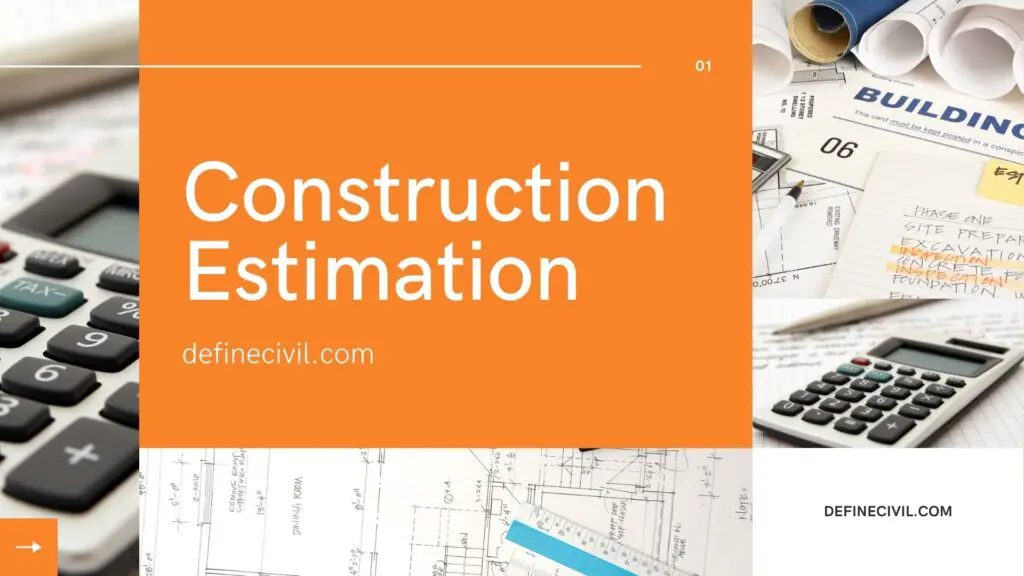Construction cost estimating is a vital component of a construction process and it means forecasting the overall cost required for undertaking a project. Whether you’re a builder or a renovator, the accurate cost estimate is crucial not only for winning the project but also to complete it on time and with a healthy profit margin.
No matter the scale of the project, construction cost estimation is a tedious process. From takeoff to costing, there’re several steps involved, and is a repeated process.
So, to get accurate construction estimates; here’re our pro tips:
Perform an Accurate Takeoff-Your cost will be as good as your numbers
The first and foremost important step in construction estimating is to go through the construction drawings and project specifications. You can’t afford to miss a detail or item. The specification both general and specific entails details for the quality of the material required and the procedure to be followed for undertaking an activity.
After that, it’s time to quantify various tasks and items included in the scope of work. Precise and accurate takeoff quantities are crucial for accurate estimates and getting profitable bids.
The takeoff has to be detailed and specific. Alongside the list and quantity, the estimator can include specific information on the required quality and type of material. For example, you should not merely write lumber in the raw material list. Break down the list with a specific number and type/sizes to complete the job. Include all raw material, fabricated material, fasteners, brackets, or allied items necessary for installation and construction.
The quantity of material should be in coherence with the type of item. For example, piping or lumber can be expressed as length. Whereas concrete or asphalt must be expressed in volume. Similarly, paint or tiles has to go in square meters.
Construction takeoff is a time-consuming process and can be a tedious task owing to the complexity of the project. You can either perform takeoffs manually or digitally using the software. For the manual method, you need to spend more time shuffling through papers and plans.
At the end of a takeoff, you get the sum of the cost of materials for the project. This cost is further added into labor costs, overheads, and profits as a final construction cost estimate.
What is your overhead?
As a contractor or a remodeler, you must know your annual overhead. That includes all indirect costs that are required to run your business. Unlike other businesses, overhead in the construction sector can be of two types: direct and indirect. Direct overhead costs may include the cost of project managers and experts visiting the site for a meeting or material delivery. While costs that impact your entire construction company from an administrative or legal standpoint, are the indirect overhead expenses like rental fees, legal fees, property payment, and taxes.
You have machinery, office lease, marketing costs, field equipment, tools, and employees; the percentage of all such expenses must be added to your sale price.
But when it comes to calculating overhead, construction business owners find themselves in a tough spot. And you can’t always guess your job costs as then, you’ll be left with less revenue at the end of the day.
Start by preparing a comprehensive list of overhead costs. Develop an organization system and keep track of all the payments and receipts. You can categorize the payments as space costs, salaries, insurance, transportation costs, utility costs, government fees and taxes, and depreciation costs. If you directly produce some goods for the project, you need to add a category for manufacturing overhead costs.
After you have a comprehensive categorical list of overheads, it’s time to add everything up. You can get the sum for some time like overheads for one month. Setting a timeframe will help you stay consistent and revise your rate as and when required. In the end, you can divide the sum of costs with the total sales for one month to get a percentage rate. As a rule of thumb, you can set 10% overhead and see how it works at the end of the month.

Your Profit Percentage Goal?
You’re in the construction business not just to stay busy but to make a profit. Don’t you? So, your profit margin or profit percentage is the most important figure in your bid or estimate. The incorrect calculation may lead to tight budgets and slow business growth. So it is crucial that add the right markup to make money while staying competitive.
Your profit is the leftover from the project’s cost and overhead. At the start of your business, you can adopt industry standards for overheads and profits but to step up in business you should calculate actual figures. It’s a little bit of trial and error but you can easily find a sweet spot by balancing your overhead and profits. You can use the profit to reinvest into business growth, reward yourself and your employees, or save it as a safety cushion for the future.
Try to start with industry-standard profit markup and see if you win projects. If you fail, try to reduce it and see the results. But if you continue to win, slightly raise this figure until you get some pushback on cost.
Determine Labor & Management Cost
In simple terms, estimating the labor costs means knowing how long it will take for your labor to accomplish a task in the project and multiply this duration with your base rate. In the construction industry, the labor cost accounts for 50% of the project cost. So, you must develop an accurate labor rate and cost. After all, you don’t want to upset your customers or pay yourself too little.
Depending on the project scope, you can enlist a construction crew. For the rate, you can start with standard wages in the industry of your area. Don’t forget to add in the labor burden in the standard wages. Labor burden is the employee’s benefits packages paid by the company including things like vacations, payroll taxes, insurance, benefits, supplies, and illnesses.
After getting the labor rate from the base rate, you can determine the labor cost by multiplying the labor rate with the number of hours they are required on the project.
Determine Material & Machinery Rental Cost
The cost of material is a major part of the entire project cost. And it varies widely depending on the project location and market volatility. If the estimated material is less than the required quantity it can result in delays in project completion and significant cost overages. On the other hand, if too many materials are ordered, it can result in losses for the contractor.
The contractor must incorporate a projected increase in material costs so they don’t incur losses due to price hikes. So try to prepare a comprehensive list of all essential materials required to complete a project and build in a buffer to account for both short and long-term material price trends.
Your bid is composed of a document called a bill of quantities. It includes an itemized list of activities and materials required to complete the project. Expected material prices are determined by looking at historical cost data and the buying cycle. But this cost is prone to fluctuation based on market condition.
Apart from material and labor costs, the cost of buying or renting heavy machinery for the project is also factored into the overall cost or overheads. Equipment costs generally include the cost of owning and operating the machinery. Ownership cost is fixed and it includes depreciation, cost of parking, property taxes, licenses, and similar costs. While operating cost is an hourly rate that includes fuel, maintenance, and similar costs. Contractors must include month-to-month rental costs on their job costs.
Factor in Percentage for Waste
No matter how effective your construction waste management is, you do need to include some allowance for material wastage. Material wastage is defined as the difference between the quantities of material delivered at the site with that utilized at the site.
Estimating waste is also beneficial for you as a company as you can make significant savings just by incorporating site waste management plans effectively. Some clients also demand to show waste forecasts for their projects. Some common causes of waste include damage in storage, damage during shifting of material, non-standard custom designs, unnecessary offcuts, and over-ordering. That’s where an accurate estimate will again help you to order only the quantity you need at the site.
Wastage rate is different for different times of material and it also depends on your construction practice. For example, for plasterboard, the wastage rate is 22.5 % for standard practice but with only a few improvements and with good practice you can lower the rate to 15%. The wastage rate for bricks is 10-20% while for the concrete blocks is 5-10%.
Add for contingencies for an unexpected expense
Every construction project is unique and has hidden challenges that call for unforeseen circumstances that may be hard for you and your budget. That’s where overall risk management strategy and making allowance for anticipated cost changes due to unforeseeable circumstances; comes in handy. This cost accounts for any error or omission in construction documents, change in scope or quality of material, and payment for unknown conditions.
Today’s construction market also demands contractors to be flexible on account of scope changes. The client may ask you to move a wall or change the opening as per changing project requirements. For such instances, the contractor has to include the cost in his bid. As a standard practice, most contractors use a rate of 5% to 10% of the total estimated cost as a contingency.
The benefits of using software
Digital estimation and takeoffs with the help of construction estimating software have benefited contractors in many ways. More and more contractors are turning to software rather than the traditional form of estimating, such as spreadsheets or manual documentation. Such applications allow you to estimate all costs and expenditures like labor costs, equipment costs, material costs, and other matters easily with just a few clicks. You can track data of stored materials and other site issues.
The benefit of hiring a construction cost estimator
When you’re a small construction company, you don’t have enough budgets to hire an in-house estimator or set up an in-house estimating department. That’s where you can outsource estimating services. Having an in-house estimating department will increase your business overheads and that too is without any profit unless you win projects. So, if you’re not winning projects due to overheads, it’s time to cut short your in-house expenses.
When you’re outsourcing, you get fast and accurate estimates that allow you to bid on more projects and increase your chance of winning more projects. You don’t have to be an IT genius and don’t have to spend day and night learning software and going through a tedious takeoff process. You can focus on what matters more to take your business to the next level of success.
Outsourcing construction estimating will pay for itself in the long-run. You not only save money by reducing overhead but with accurate estimates you always have healthy profit margins at the end of the project. You can further invest your savings in your business or get new assets that will help you get ahead in a highly competitive market.




















Thanks for posting an amazing blog construction software. I read your complete blog and you explained everything very well. Today’s construction market also demands contractors to be flexible on account of scope changes. I also really agree with this statement of you.
Once again thanks for posting amazing info. Keep posting such types of blogs.